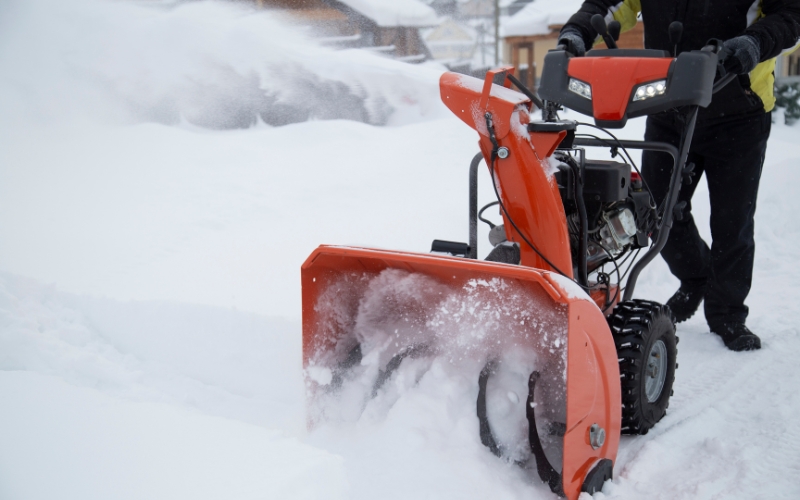A snow blower is a handy machine to have during the winter season. It helps clear your driveways, sidewalks, and other areas of snow. However, like any other machine, a snow blower requires proper maintenance. One critical component of a snow blower is the carburetor, which mixes fuel and air to power the engine. Over time, dirt and debris can build up in the carburetor, affecting the snow blower’s performance. When cleaning your snow blower’s carburetor, you have two options. The first is to remove the carburetor from the engine before cleaning it, while the second option is to clean it while it is still attached.
With the carburetor removed
If you choose to remove the carburetor, here are the steps you can follow:
Turn off the snow blower:
Before cleaning the carburetor, please turn off the snow blower and allow it to cool down completely. It will prevent any potential accidents while cleaning.
Locate the carburetor:
Locate the carburetor on your snow blower. It’s usually found near the engine and has a fuel line attached. Check the manual or online resources if unsure where to find it.
Remove the carburetor bowl:
Using a screwdriver, remove the carburetor bowl, usually held in place by a few screws. It will give you access to the inside of the carburetor.
Spray with carburetor cleaner:
Using a can of carburetor cleaner, thoroughly spray the inside of the carburetor and bowl. It will dissolve any built-up grime or debris.
Clean the small holes:
Using a small wire or a toothbrush, clean the small holes in the carburetor and the bowl. It will help to remove any remaining debris or dirt.
Reassemble the carburetor:
Once you’re done cleaning, reattach the carburetor bowl and screws. Make sure everything is tightened properly to prevent any leaks.
Test the snow blower:
Turn on the snow blower and test it to ensure it runs smoothly. If you notice any problems, you may need to repeat the cleaning process or seek help from a professional.
Without removing the carburetor:
Cleaning your snow blower carburetor can be challenging, but ensuring its effective functionality is essential. While removing the carburetor is a common method, it’s not the only one. Following are the steps to clean your snow blower carburetor without removing it.
Materials Needed:
- Wire brush
- Carburetor cleaning solution
- Can of compressed air
- A piece of copper wire Allows the Snowblower to Cool Down:
- Before cleaning, ensure the snow blower is turned off and give it time to cool down. This step is crucial to prevent burns or injuries.
Remove the Muffler:
Removing the muffler provides easy access to the carburetor. Remove the bolts and screws as indicated in the manual.
Remove the Oil Tank:
Carefully remove the oil tank, ensuring that gas doesn’t spill. Slide the fuel tank to keep the cleaning solution from getting into the oil.
Drain Oil from the Carburetor:
Place an empty container under the carburetor bowl before draining the oil. Wait until the carburetor is empty before cleaning.
Drain the Fuel:
After draining the fuel, wash the carburetor bowl with a wet cloth.
Clean the Nuts:
Spray enough cleaning solution on the nuts and use a wire brush to clean them thoroughly. Clean the
Carburetor Holes:
Use a piece of copper wire to clean the carburetor holes. Spray cleaning solution around the carburetor’s throat to remove deposits within the throttle area.
Use Compressed Air:
Spray compressed air on the carburetor to ensure it’s thoroughly cleaned.
Reassemble the Parts:
Reassemble the various parts, ensuring no errors or impurities are left behind. A slight mistake could affect the snow blower’s functionality later on.
How to keep the snow blower carburetor in great condition?
If you own a snow blower, you know how important it is to keep it running smoothly during winter. Maintaining and cleaning your carburetor can help ensure that your snow blower operates at peak performance, saving you time and frustration. Here are some tips for keeping your snow blower carburetor in great condition.
Regular Cleaning:
One of the best ways to maintain your snow blower carburetor is to clean it regularly. Dirt, debris, and other contaminants can build up in the carburetor, causing blockages and leaks that can impact performance. A simple cleaning can help expose these issues and push clean air through the carburetor to keep it running smoothly.
Remove the Gas:
Another important tip for maintaining your snow blower carburetor is to remove the gas when it’s not in use. Over time, gas can break down and leave behind a gummy residue that can clog the carburetor. If you’re storing your snow blower for an extended period, removing and disposing of the gas properly is a good idea.
Use the Right Cleaners:
When cleaning your snow blower carburetor, using the right cleaners is essential. Some cleaners can be too corrosive and unsuitable for cleaning your carburetor, while others are formulated for specific carburetor models. Before purchasing a cleaner, research to ensure it’s appropriate for your carburetor.
Signs your carburetor needs to be cleaned:
Maintaining a clean carburetor is crucial for enhancing the performance and lifespan of your snow blower. Therefore, it is recommended to be mindful of the signs that indicate a dirty carburetor, as taking action promptly can save you from bigger problems later on. Here are some indications that suggest it’s time to clean your carburetor:
- If the engine is difficult to start or keeps stalling, it indicates that your carburetor needs cleaning.
- The emission of black smoke implies that the fuel-air mixture is rich and has excess fuel, which is another sign that the carburetor needs cleaning.
- A lean fuel mixture causes jerks and uneven acceleration due to the fuel supply disruption caused by clogging.
- An increase in fuel consumption can indicate excess dirt in the carburetor.
- Long periods of inactivity can cause dirt to settle in the carburetor.
- Flooding of the engine is caused by debris on the needle valve spilling fuel, which indicates that the carburetor needs cleaning.
- Backfiring or overheating the engine also suggests cleaning the carburetor is time.
- Excessive engine noise when idle may be due to dirt and debris in the carburetor.
Summing up:
Cleaning the carburetor is an essential maintenance task for a snow blower. A dirty carburetor can lead to several issues, like difficulty starting the engine, uneven acceleration, and increased fuel consumption. There are two ways to clean a snow blower’s carburetor: removing it from the engine or cleaning it while it’s still attached. It is important to remember to follow safety precautions and to refer to the manufacturer’s instructions for specific details related to your snow blower. Regular maintenance and cleaning of the carburetor can extend the life of your snow blower and keep it functioning properly for years to come.

